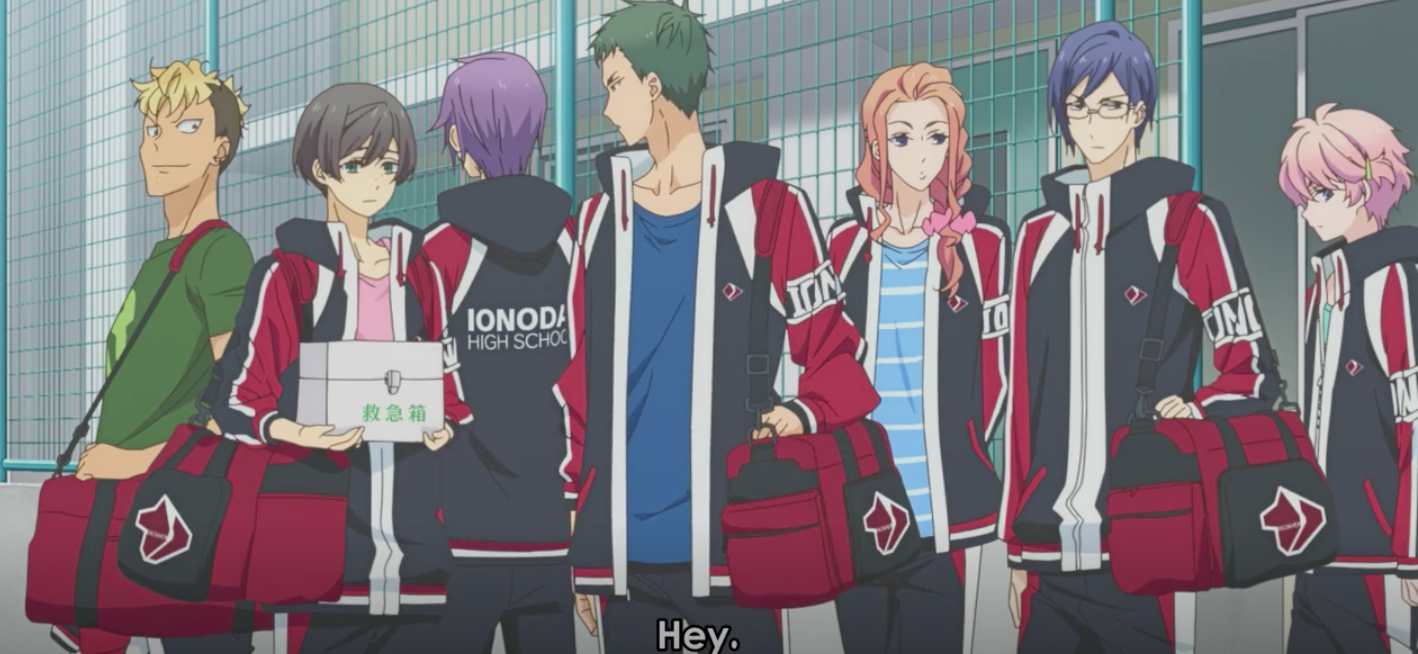“Sport” Anime and Why They is
Jacey Chen (ISB G11)
After obsessivly watching Haikyuu!! until the latest season (her internet is going through some tough times, it recently went through a break up), Jacey (ISB 11) wondered if there were any other amazingly good sports anime like it. However, through her exhausting efforts of finding good sport anime (and fin ishing them before the deadline), she decided that she didn’t see enough women be cool and play sports. Thus, this analy- sis of the stereotypical, layout-led sports anime genre was born.
Ah, yes, sports anime. The one where typically young and ideal men depraved women go to seek refuge. Now, the sports anime I will be referring to in this train-wreck of an article are those similar to Haikyuu!!, Free!, and Skate-leading☆Stars (a relatively new sports anime.) The points I go over may even sound similar to anime surrounding a group of characters like Boku no Hero Academia, Tiger & Bunny, and Yarachin☆Bitch-bu Bungou Stray Dogs (to only name a few). This is because one of the reasons people watch shows with groups is due to the ships interactions between characters and their personalities. I will not be going over anime such as Yuri on Ice!!! because it strays far from the usual group routine (plus it’s straight-up shonen-ai) and not something you see in your average sports anime. Speaking of your typical sports anime, what does one entail?
Sports anime always begin with a certain type of main protagonist, one that is determined to improve and do their best, one with talent (well, most of them have human defying talent) but does not activate it until they meet someone (weewoo weewoo ship alert) along the way to help them, and one, usually within the structure with deprecating or super gung-ho main characters, who has lost something and need to get it back (this ‘something’ is usually reputation or a challenger.) These protagonists are what drives the story of the anime forward, and without them, other characters usually do not thrive (or start moping around.) This is done in order to raise the importance of the main character, not to boost how relatable the character is, which is strange since #relatable content is often common in many story-based media. The main character’s importance gives the audience a reason to cheer and hope for that character’s, and their team’s, success. Other characters within the team also build up their success (and sell-ability), with the most common and consistent ones being the hot-head, the clueless one, the rule-follower, the queer (or overly feminine for no reason) one, the quiet one, and the big baby everyone wants to take care of. Cliche character dynamics are also very common sport anime teams like the mom and dad, the rule-breakers, the I’ll follow you everywhere until my feet fall off, and many more. Don’t even get me started on the opposing team; the teams our protagonist goes up against allows for more character diversity and opportunity for more ships character interactions and dynamics. Opposing teams are used to initiate a reason to improve for the main character and their team, allowing the story to progress even further; this progression usually follows a series of technical and emotional improvements when in contact with the sport.
In order to tackle technical improvements in the character, there must be an explanation for the sport. Referring back to Haikyuu!!, the anime does an excellent job in explaining the positions and their roles during the anime. Its explanations are detailed to the extent where my friends and I (who’ve played volleyball) are able to agree with the rules, while those who haven’t played the sport can easily learn the rules and how to play. Sometimes in sports anime, the coach may discuss a technique with a character, but at the same time, the audience absorbs the technique as well. Haikyuu!! is an obvious exemplar of a sports anime that does this. Others that I’ve seen do not do this as much (God of Highschool, and a few other supernatural sport-based anime), but I believe this addition allows the anime to reach a greater range of viewers and allows them to fully enjoy the show.
After the Rocky montage episodes of improvement, tournaments and battles are up next. The few battle episodes often revolve around overcoming opponents that the audience has been introduced to in previous episodes, or even friendships that transgress into passionate love-making friendly competition. It’s common in sports anime to be introduced to very minor opponents (the first ones to be beaten) during the same training episode or in a previous episode very briefly, going over the team’s background story in an attempt to appeal to pathos and encourage audiences to have a difficult time in being able to side with only one team. The ability to this effectively differs from anime to anime, some being much better than others. However, we also see the main team confront get defeated by stronger teams that we commonly get reintroduced to later in the series, this only fuels their determination (kind of like a save point.) The calculation of score and success is normally those weird branch score things (I call them Bracket Battles) that aren’t really fair, but they will do; this leads to the common goal of winning some sort of national tournament. In order to accomplish this goal, the team must beat the other opponent; this gives the team and the audience a sort of checkmark that further realizes the teams’ goal and heightens the viewer’s hope.
Now, here’s the real question, what really makes up a successful sports anime? Men, lots and lots of men, all types of men. Here’s the logic people think makes a good sports anime: the more variety and the more quantity of men THE BETTER (This is a sarcastic statement.) The reason why I really like Haikyuu!! is how I see it as a realistic sports anime (as realistic as it can get), no flashy hairstyles, a variety in stature, and no overarching and static personalities (I mean just look at Kageyama and Tsukki get excited when they win after working on their personalities for like 2 seasons, that’s real character development). What really drags in the audience is truly the personalities and dynamics (I’m sorry, it’s really all about the shipping I can’t keep trying to make light of this situation anymore.) Watching Yuri on Ice!!! but with teamwork (Skate-leading☆Stars) is a very tiring experience; this is due to the lack of purpose each character has, the lack of backstory, personality, and the constant additions of these random characters that seem important but are a complete BORE. Circling back to talking about the extent of colorful boys, there never seem to be an extent of colorful GORLS. When I look through the ‘sports’ tag, I have only come across ONE sports anime consisting of a women’s team. What does this mean exactly? The audience has something to do with the amount of sports anime not only containing women but containing good CONSUMABLE (nom nom yummy) content.
DEMOGRAPHIC, this is my favorite section. After deciding to write an article about this topic, I’ve realized the lack of sports anime I’ve consumed in my past 8 years of constant consumption. I am not in the normal colorful cool guys demographic that these anime are trying to reach (thank god, for you. I’m really just here for the ships, but sometimes that’s not even tangible with the material I’m given.) However, with my *nudges glasses* thorough research, I’ve deduced that the demographic these types of anime are trying to reach are largely female, around their teens, and those who are also there for some good shipping action. Rarely do you see a viewer arrive for the plot or deep meaning of the story, or even for a drama-ridden rendition of a sports game (this is similar to a *cough* another genre very different from sports anime.) The problem with sports anime is that it lacks a variety in story-telling driven by the type of sport that is being played (Haikyuu for example not only has accomplishments in volleyball but the plot allows for more character building, Tsukki as another example, learns to not be such a prick.) Anime surrounding a group of people working together to accomplish the same goal willingly is only good if done right. The giant influx of extremely boring or meaningless sports anime may be due to the formula that gets tossed around from company to company that seems to gain good results but restrains the genre from reaching out to larger audiences and become more interesting. Haikyuu!! is definitely an exemplary example (even though I tend to find it boring sometimes; I’m sorry my internet’s ability to load and my patience level is painful.) It proves everything I said about the carbon-copy listing of the plot earlier in the article to be the opposite and has gained an extremely large and differentiated audience.
TL;DR, the majority of sports anime have no depth, no interesting back story, and no normalcy that can attract those looking for an interesting time. To get out of this loop we need to think more about how do we make the characters’ personalities and goals interesting? How do we show that they are more than the sport they are playing? How do we show that they are more than a leverage to help the main character grow? And don’t worry about the characters looking bland, the humor, story-writing, and characters’ personalities should make up for that, trust me, I’ve gone down the Haikyuu!! text to speech YouTube rabbit-hole for far too long.







